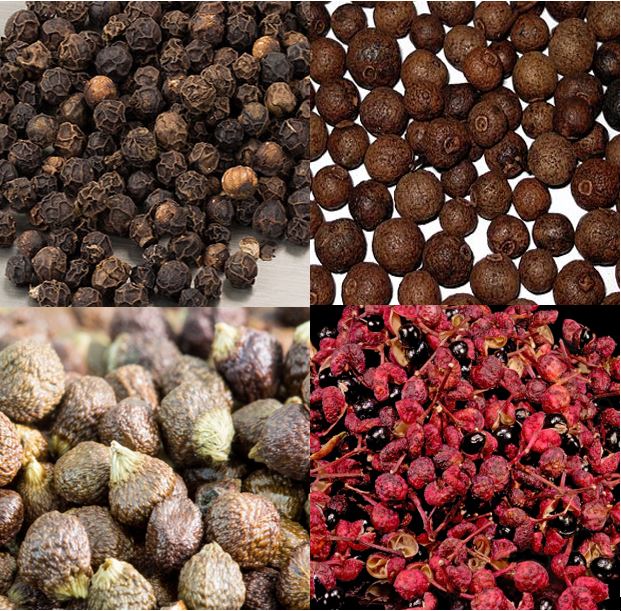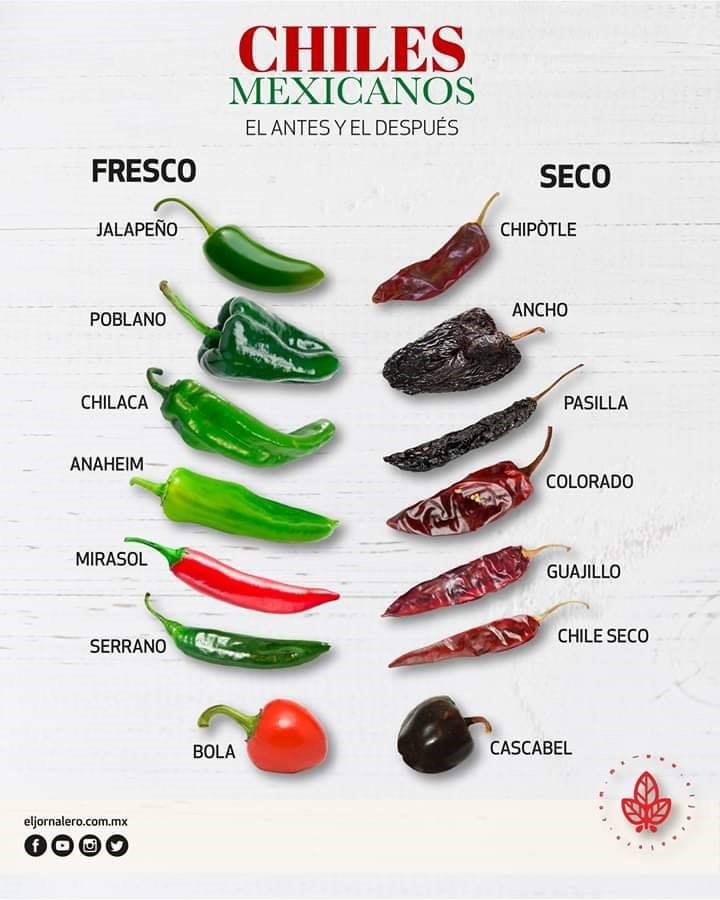Hot pepper, sweet pepper, black pepper? Chili, chile, chilli? A peek into the confusing naming conventions of peppers.
A brief history of how local cuisine and worldwide trade networks contributed to the tongue-tied world of peppers and their chiles.

Peppers ignite the hearts and mouths of many food-lovers, but how did they come to share a name with black pepper? And what makes a pepper a chile, chili or chilli? While they all share common origin points in Central and South America, five main species of peppers have diversified commercially across the globe according to “Capsicum—An Abbreviated Compendium” from Robert L. Jarret et. al: Capsicum annuum, C. baccatum, C. chinense, C. fructescens and C. pubescens. In their travels, they have been used as food, medicine, weapons, pesticides, and art that is closely tied with the geographic origins of ethnicity, culture and language.
Over 8,000 varieties are currently on record to have been developed from these species, and there were likely thousands more over the centuries. Varieties with sweetness and heat were maintained depending on the cooking culture where they were developed. As you can imagine, naming is important when a searing hot fruit looks identical to a fruity sweet one. However, with European imperialism, immigration, the internet and globalized food markets, the naming conventions for peppers and their chiles has always been, let’s say…spicy.
What is a pepper?
There has been confusion over what plants and products get called “pepper” dating back as far at the 15th century, when the first European explorers reached the new world from Spain and Portugal. These explorers were familiar with black pepper (Piper nigrum), a hot pungent powder made from the dried berries, or peppercorns, of a vining plant native to India. When European traders first acquired allspice (Pimenta dioica) in the Caribbean and grain of paradise (Aframomum melegueta) in Africa, they called them pepper as well due to their similar appearance to peppercorns.
Regardless of the mistaken identities, European demand for these spicy flavors quickly exploded, and when dried capsicum peppers were first traded with Spanish explorers in Central America, they were known by their native name of aji, axi or achi. However, the dried and crushed fruits were used similarly to black pepper, and so Europeans started calling it pepper too.

Interestingly, because black pepper, allspice and other exotic dried plant products could only be grown in tropical environments, exclusive governmental trade contracts controlled the supply and the price. When horticulturalists found that capsicum peppers could be grown in Europe, this was at first celebrated as a worthy replacement for the more expensive imports. By 1570 much of Europe had been introduced to them as a garden crop and began to enjoy them as fresh fruits in addition to a dried product. One author wrote in 1565, “The sole difference is that while that of the Indies (black pepper) costs many ducats (an old European currency); the other one (capsicum pepper) costs only the effort of sowing it.” This accessibility caused capsicum peppers to later become derided as “a vile and rustic food” grown by poor people who could not afford black pepper, according to 2015 research from Stefan Halikowski Smith.
Unlike other dried bulk staple goods like black pepper, capsicum peppers were untaxed and unrecorded in most trade ledgers. Yet, seeds were traded overland and by seas among the very same poor itinerant sailors and trade caravan workers who were tasked with trading black pepper. It was this side hustle that spread capsicum peppers to the Middle East, India and Asia, where even more cultures gave them even more names, according to “Chiles’ Global Warming” by Deana Sidney. Even here, the convention of naming plants with that looked like black pepper continued. One example of this is the Sichuan pepper, named for the Sichuan region of China known for their heavy use of hot capsicum peppers in their cooking. However, the Sichuan pepper is actually the small bead-like fruit from a northern-latitude tree species in the citrus family that the Chinese call “jiao.” When black pepper made its way to China, people thought it looked like jiao, and began referring to it as “hu jiao” after the nomadic traders, called “hu,” that were likely the traders who introduced it to the area. When back-translated, even this citrus tree became a confused pepper.
What is a chile?
Essentially, a pepper becomes a chile when it is picked at peak ripeness and dried; much like a grape becomes a raisin or a plum becomes a prune. All spellings of chile, chili or chilli are acceptable. As a capsicum pepper fruit ripens, the capsaicin content, or heat, in its seeds and placenta (the white tissues seeds are connected to) increases. However, not all peppers produce significant levels of capsaicin, and a pepper does not have to be hot to be a chile. Some chiles are sweet and chocolatey.

Sometimes a variety was given a name for eating as a fresh immature green pepper and a separate name once ripened to a mature color and dried as a chile. Some of these dual-purpose peppers/chiles include red poblano/ancho, brown poblano/mulatto, chilaca/pasilla and jalapeno/chipotle. Some peppers have one name because they are only used dried and are often called chiles, regardless of if they are fresh or dried. Examples include serrano, cayenne, paprika, de arbol or guajillo peppers.
Finally, some other one-name peppers are used more often as a fresh food and rarely dried. For example, banana, bell, habanero, Hungarian or Marconi peppers. Some regions of the same country even have different names for the same pepper and different names for the final chile depending on whether it was sun dried or smoke dried.
Most chile peppers are grown in places with some combination of seasonally high temperatures and aridity, sunshine and long frost-free periods. These climatic features allow for some or all the drying to take place in open air. The leading production and export regions are China, Mexico, Turkey, Indonesia, India and Spain.
Can we grow and dry chiles in Michigan? Can Michigan-grown and dried chiles compete in the international spice trade? These were questions asked by a local sauce-maker who wanted to make mole (pronounced moh-lay) sauces from Michigan-grown and Michigan-dried chiles. Moles are a Mexican sauce made from large-fruited, sweet and mild-heat varieties, including poblanos, pasillas and guajillos. Read the results of a chile pepper variety trial and drying evaluation that Michigan State University Extension performed in 2018 in “Chile pepper production trial in Michigan.”



 Print
Print Email
Email

